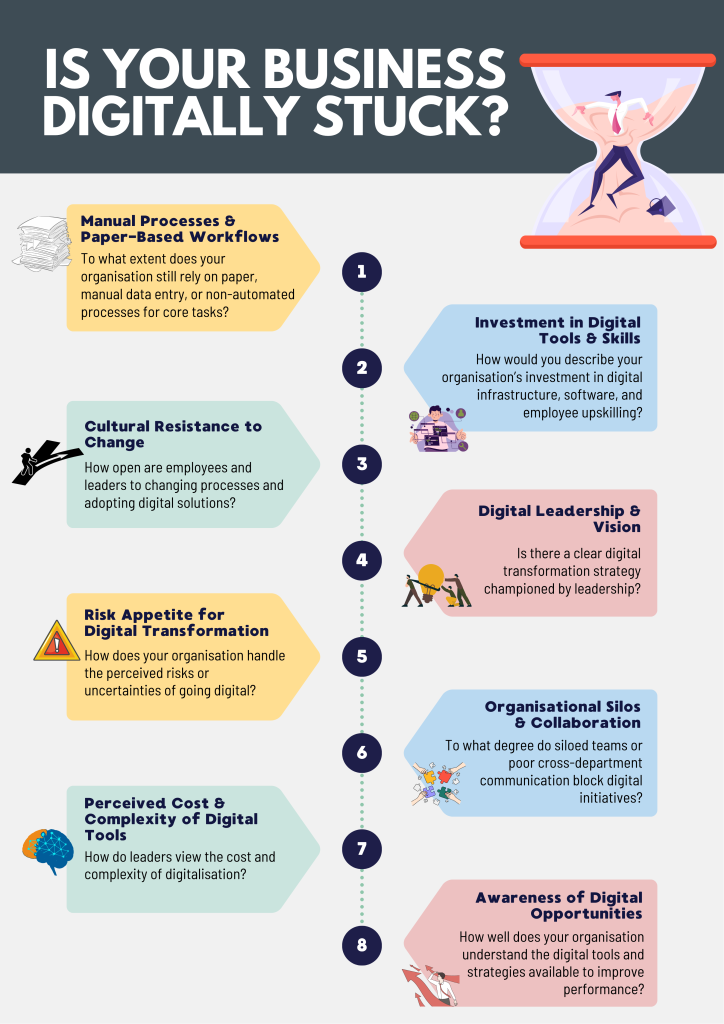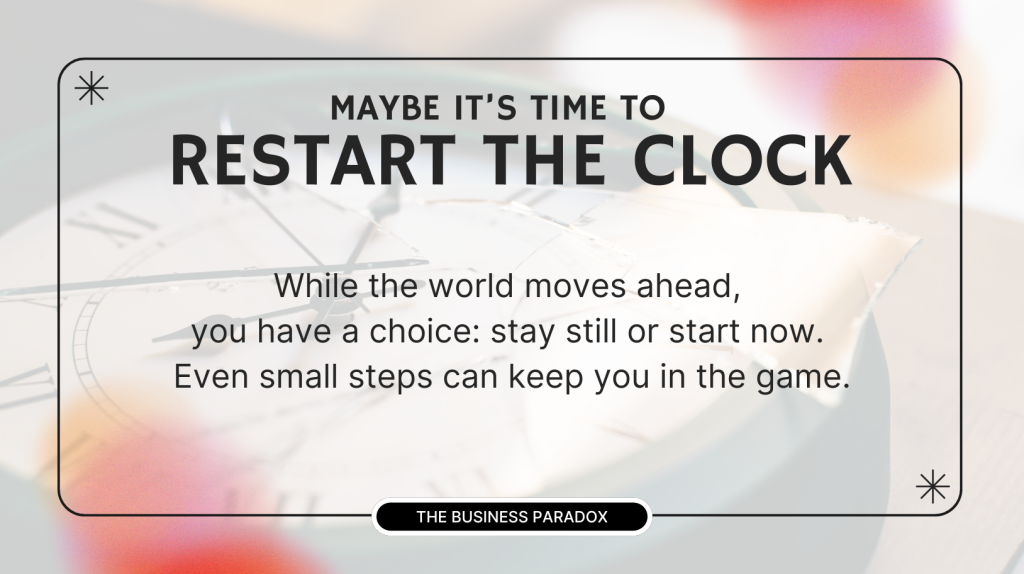Are You Still Running Your Business Like It’s 1995?
We live in an age defined by digital signatures, seamless cloud collaboration, and powerful AI. Despite having endless tools for efficiency at our fingertips, a shocking number of companies and professionals remain stubbornly anchored in the analog past. The continued reliance on hardcopy documentation, mandatory in-person approvals, and manual processes actively stalls progress and productivity. This persistence of 1990s playbooks begs the central question: Why do so many successful leaders and companies knowingly choose to resist transformation?
The answer lies not in outdated technology, but in deep-seated human psychology. This instinct to cling to the familiar, even when innovation offers a clear advantage, is known as the status quo bias. We fall prey to loss aversion, instinctively fearing the effort, cost, and uncertainty of new digital systems far more than we value their potential benefits. Most decisions inside organisations, including those made at leadership level, are shaped by habit and mental shortcuts. Without intentional reflection on long-term goals, we tend to default to what feels comfortable. To break this organisational inertia and future-proof your business, we must first understand the forces that keep us perpetually stuck. As a leader, recognising these patterns in yourself and your organisation is the first step toward meaningful transformation.
Here Are Some Signs Your Organisation Is Stuck in the Past
Organisational inertia is the subtle force that keeps companies doing things the way they’ve always done them. It’s that quiet resistance to change rooted in habit, complexity, and the human tendency to stay with the known. If your organisation is still demanding hardcopy printouts and physical signatures for routine approvals, insisting on mandatory, frequent in-person meetings that could be an email, or relying on outdated software, it is probably holding onto more than just tradition. This resistance also manifests in subtle cultural habits, like prioritising office presence over actual outcomes (i.e., rigid 9-to-5 schedules) or valuing “face time” more than demonstrable results.
Often, these environments are staffed by employees who have been with the company for decades. You could have a loyal and experienced workforce, but they may be deeply embedded in legacy ways of working. In these cases, entire teams become collectively anchored to the past, reinforcing outdated habits simply because “it’s how we’ve always done it.” This creates a kind of cultural inertia that makes change feel uncomfortable or even threatening.
While these habits may offer a sense of control, they increasingly clash with the expectations of the modern workforce and the agility required to stay competitive. It may feel safe internally, but it creates serious friction externally. Customers, suppliers, and business partners increasingly expect efficient, tech-enabled collaboration because that’s how they work. When your systems are slow, manual, or outdated, it ends up slowing theirs too. All that frustration will add up and could cost you credibility, trust, and future opportunities. In today’s dynamic markets, clinging to the status quo incurs a double penalty: reduced productivity and fractured relationships. Holding onto outdated norms sends a signal to the outside world that your business isn’t evolving.
To help you quickly assess where your organisation stands, here’s a simple self-assessment guide:

The Hidden Costs of Doing Nothing
Simply put, the cost of doing nothing is irrelevance.
On the surface, postponing digital transformation may appear to be a practical decision to minimise disruption and conserve resources. In reality, the costs of inaction are rarely immediate but they build quietly. The real price of inaction compounds over time: lost competitiveness, declining relevance, and shrinking adaptability. Every year you delay digital transformation, your systems age further, the gap between your business and industry standards widens, and the complexity of integration increases. By postponing change, you’re building a bigger, more expensive problem to solve later. When you eventually do try to modernise, you’ll have more tools to adopt, more data to clean, more systems to replace, and more people to retrain.
Inside the organisation, outdated ways of working can frustrate those who see the need for change but they also create a culture of quiet complacency. When employees are content with doing things the way it’s always been done, it may seem like everything is running smoothly. Yet, comfort shouldn’t be mistaken for progress. If your employees aren’t evolving, neither is your business. If your team isn’t curious, experimenting with new tools, or looking for ways to improve, your business will struggle to stay competitive. Complacency at the individual level compounds into stagnation at the organisational level. Meanwhile, technical debt grows, systems continue to age, and the cost of catching up increases.
Of course, change is hard and it’s almost always messy. For companies built on decades of tradition and processes that once delivered success, the pressure to change can feel overwhelming. Leaders who’ve spent their careers mastering the old ways can suddenly feel unprepared, uncertain, or left behind. Resistance to change is often rooted in fear. The fear of failure, fear of not knowing, and fear of losing control. That is completely normal. For many, it’s not a lack of willingness to improve, but they genuinely do not know how to take the first step. It often begins with understanding change is necessary and the courage to move forward despite the discomfort.
Breaking the Cycle: How to Bring Your Team into the Now
The initial steps toward digital transformation should not focus on launching new software, but on addressing the human instinct to resist change. Leaders must understand that overcoming inertia is about designing change that feels safe, gradual, and aligned with human behaviour.
You may look around and feel like you’re too far behind to catch up. But that sense of being “late” is just a mental barrier, not a real one. Starting today, even with small, focused steps, is far more powerful than staying still. What matters is momentum. Even one team retrained, one manual process automated, or one system updated moves you forward. The best time to begin is always now.
1. Introduce Change Gradually Through Incremental Steps
Framing digital transformation as a continuation or gradual enhancement of current processes helps ease fears. Using simple, reassuring language that highlights what remains the same helps employees feel more secure and reduces uncertainty about how their day-to-day work will be affected. By implementing digital shifts incrementally and in manageable stages, organisations can reduce the perceived threat and grant employees a sense of control. It begins with simple, low-risk moves: a pilot project, a skills audit, or removing one inefficient bottleneck.
2. Engage Employees Early and Involve Them Throughout the Process
While new digital tools are essential, their success depends on people’s willingness to adopt and use them effectively. Resistance often stems from feeling unheard and excluded. Inviting employees to participate in pilot projects, focus groups, or scenario planning helps surface concerns early and builds a sense of ownership. When staff feel heard and involved, they are more likely to support the change and help shape its success.
3. Establish Continuous Feedback Loops to Improve
Change is rarely perfect on the first try. Creating channels for ongoing employee feedback allows leaders to monitor morale, identify obstacles, and make timely adjustments. Demonstrating responsiveness through these loops builds trust and reinforces that transformation is a collaborative journey.
Conclusion: Don’t Let Your Business Become a Broken Clock
A business stuck in the past is like a clock frozen at the same hour: time moves on, but they remain out of sync with the world around them.
Organisations often hold on to familiar ways of working like a trusted old clock, once reliable, comforting, and perfectly in sync. And that is understandable. For companies with deep histories and legacies to protect, change can feel like a risk to all they’ve built. But maybe the clock needs a reset to keep ticking with the times. The good news? You don’t have to abandon your past, you just have to realign with the present. Customers, business partners, and employees are evolving, and so are the tools and technologies that support them. By embracing change with intention and clarity, your business can stay in rhythm with the world around it. Digital transformation is about staying relevant, resilient, and ready for what’s next.

Your clock may not be broken, it could just need winding. Reset it and you’ll find that progress only requires the willingness to begin. No matter where you’re starting from, it’s not too late to catch up, realign, and move forward with purpose.
Stay ahead with exclusive insights! Sign up for our mailing list and never miss an article. Be the first to discover inspiring stories, valuable insights and expert tips – straight to your inbox!




